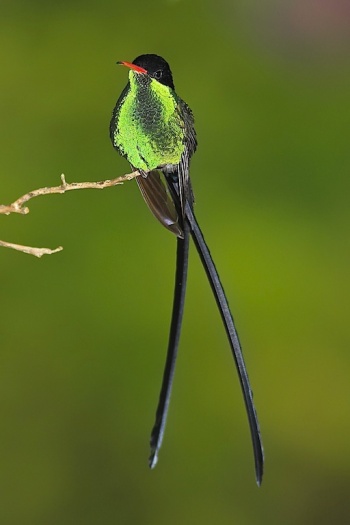| This article is incomplete. This article is missing one or more sections. You can help the BirdForum Opus by expanding it. |

Photo by Stanley Jones
Just outside the Village Lacovia, Jamaica, November, 2010
Overview
The third largest island in the Caribbean, Jamaica is home to 25 species and a further 20 or so subspecies that are endemic to the island. Around 200 species are regular breeders, passage migrants or winter visitors and another 50 have been recorded as vagrants.
Most of Jamaica's original forest cover has been cleared but there are still areas of montane forest in the Blue Mts of the east, wet limestone forest in the John Crow Mts of the far east, the Cockpit Country of central Jamaica and at Dolphin Head in the west as well as dry limestone forest on parts of the south coast.
Excellent wetlands survive at Great Morass in the far south-east and in the Canoe Valley and the Black River Lower Morass of the south coast.
Birds
Notable Species
Blue Mountains
The road between Newcastle and Hardwar Gap in the Blue Mts gives easy access to montane forest birds such as Ring-tailed Pigeon and Plain Pigeon and Crested Quail-Dove, Jamaican Tody, White-eyed Thrush, Rufous-throated Solitaire and the rare Jamaican Blackbird.
Montego Bay
For those staying at Montego Bay on the north coast there is excellent birding at Rocklands Bird Sanctuary, aka Rocklands Feeding Station near Anchovy, St James. A small entrance fee to this private feeding station will guarantee Red-billed Streamertail, Jamaican Mango and Black-faced Grassquit and the surrounding woodland holds various doves and cuckoos, Jamaican Owl, Jamaican Becard, Jamaican Oriole and Orangequit. Guides are available to assist birders in this area.
A similar range of birds can be seen in the sugar plantation at Good Hope which can be visited by prior arrangement.
Cockpit Country
The wet limestone forest of the Cockpit Country can be explored via the rough road from Clark's Town to Albert Town. Endemics to be found here include Black-billed Amazon and Yellow-billed Amazon, Chestnut-bellied Cuckoo and Jamaican Crow.
Almost all Jamaica's endemics can be seen at Marshall's Pen, near Mandeville, Manchester. This private reserve can be visited by prior arrangement.
Portland Ridge
The arid scrub of the Portland Ridge, Clarendon, in the far south of the island is home to doves, Stolid Flycatcher and Bahama Mockingbird. White-tailed Tropicbird nest on cliffs near Hector's River, Portland, in the east of Jamaica and Black-billed Streamertail can also be seen in the area.
Black River Morass
Jamaica's best wetland for birds can be found at Black River Morass, St Elizabeth Parish in the south-west. A variety of waterbirds including Black-billed Whistling Duck, herons, rails and wintering waders can be seen in the Lower Morass and nearby Parrottee Ponds.
The Upper Morass has been drained but the area around Elim still holds breeding Black-crowned Night Heron and Limpkin. Another good wetland with Least Bittern, Glossy Ibis and American Coot can be found at Caymanas Dyke Ponds, St Catharine, near Kingston.
Check-list
Birds you can see here include:
Least Grebe, Pied-billed Grebe, Wilson's Storm Petrel, White-tailed Tropicbird, Brown Pelican, Brown Booby, Magnificent Frigatebird, Great Blue Heron, Great Egret, Tricolored Heron, Little Blue Heron, Snowy Egret, Western Cattle Egret, Green Heron, Black-crowned Night Heron, Yellow-crowned Night Heron, Least Bittern, American White Ibis, West Indian Whistling Duck (vulnerable), Blue-winged Teal, Masked Duck, Ruddy Duck, Turkey Vulture, Osprey, Red-tailed Hawk, American Kestrel, Peregrine Falcon, Helmeted Guineafowl (introduced), Limpkin, Clapper Rail, Yellow-breasted Crake, American Purple Gallinule, Common Gallinule, American Coot, Northern Jacana, Black-necked Stilt, Grey Plover/Black-bellied Plover, Semipalmated Plover, Wilson's Plover, Killdeer, Short-billed Dowitcher, Whimbrel, Spotted Sandpiper, Greater Yellowlegs, Willet, Lesser Yellowlegs, Ruddy Turnstone, Sanderling, Semipalmated Sandpiper, Western Sandpiper, Least Sandpiper, Bonaparte's Gull, Laughing Gull, Brown Noddy, Sooty Tern, Bridled Tern, Least Tern, Black Tern, Roseate Tern, Royal Tern, Sandwich Tern, Ring-tailed Pigeon (endemic - vulnerable), Rock Pigeon (introduced), White-crowned Pigeon (near-threatened), Plain Pigeon (near-threatened - very rare), European Turtle Dove (introduced), African Collared Dove (introduced), Mourning Dove, Zenaida Dove, White-winged Dove, Common Ground Dove, Caribbean Dove, Crested Quail-Dove endemic - near-threatened), Ruddy Quail-Dove, Blue-headed Quail-Dove (introduced - endangered), Olive-throated Parakeet, Green-rumped Parrotlet, (introduced), Yellow-billed Amazon (endemic - vulnerable), Black-billed Amazon (endemic - vulnerable), Mangrove Cuckoo, Jamaican Lizard Cuckoo (endemic), Chestnut-bellied Cuckoo (endemic), Smooth-billed Ani, American Barn Owl, Jamaican Owl (endemic), Northern Potoo, Antillean Nighthawk, Black Swift, White-collared Swift, Antillean Palm Swift, Jamaican Mango (endemic), Red-billed Streamertail (endemic), Black-billed Streamertail (endemic), Vervain Hummingbird, Belted Kingfisher, Jamaican Tody (endemic), Jamaican Woodpecker (endemic), Jamaican Elaenia (endemic), Greater Antillean Elaenia, Jamaican Pewee (endemic), Gray Kingbird, Loggerhead Kingbird, Sad Flycatcher (endemic), Rufous-tailed Flycatcher (endemic), Stolid Flycatcher, Jamaican Becard (endemic), Caribbean Martin, Barn Swallow, Cave Swallow, Bahama Mockingbird, Northern Mockingbird, Rufous-throated Solitaire, Grey-cheeked Thrush, Red-legged Thrush, White-eyed Thrush (endemic), White-chinned Thrush (endemic), Jamaican Crow (endemic), Common Myna (introduced), European Starling (introduced), House Sparrow (introduced), Red Bishop (introduced), Yellow-crowned Bishop (introduced), Nutmeg Mannikin (introduced), Chestnut Munia (introduced), Tricolored Munia (introduced), Jamaican Vireo (endemic), Blue Mountain Vireo (endemic - near-threatened), Warbling Vireo, Black-whiskered Vireo, Jamaican Euphonia (endemic), White-winged Crossbill, Northern Parula, Yellow Warbler, Cape May Warbler, Black-throated Blue Warbler, Yellow-rumped Warbler, Prairie Warbler, Palm Warbler, Arrow-headed Warbler, Black-and-white Warbler, American Redstart, Ovenbird, Northern Waterthrush, Louisiana Waterthrush, Common Yellowthroat, Bananaquit, Yellow-faced Grassquit, Black-faced Grassquit, Yellow-shouldered Grassquit(endemic), Orangequit (endemic), Greater Antillean Bullfinch, Saffron Finch (introduced), Grasshopper Sparrow, Jamaican Spindalis (endemic), Bobolink, Jamaican Blackbird (endemic - endangered), Greater Antillean Grackle, Shiny Cowbird (introduced), Jamaican Oriole
Other Wildlife
To do
Site Information
History and Use
To do
Access and Facilities
Jamaica is a very popular holdiay island with plenty of accommodation, easy car hire, etc. Most visitors stay on the north coast at Montego Bay or Ocho Rios but most roads are good except across the Cockpit Country which may require 4WD.
Contact Details
To do
External Links
Content and images originally posted by Steve
Pages in category ‘Jamaica’
This category contains only the following page.



